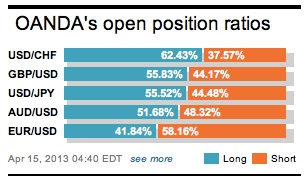Reports revealing that Chinas growth is losing momentum are a blow to risk asset prices this Monday morning. Weaker than expected Chinese Q1 GDP growth of +7.7%, y/y (+8.0% expected), combined with the tired US data on Friday (retail sales and consumer confidence headlines) has equities, FI and commodities under pressure – it seems that cash is trying to be “King” for a day at least. The softer Chinese data has triggered a mass liquidation of EUR/JPY longs, the chief driver pushing the 17-member single-currency lower. The rest of the market continues to focus on gold, the precious metal that has managed to fall another $100 already in late Europe and before the US investor has managed to lick their wounds from Friday’s dumping of 400 tonnes or $20-billion worth of futures on the COMEX.

Can Commodity price history repeat itself? So far, its mission accomplished for the commodity bears. The metal’s back was broken early on Friday in NY ($1,540) and since then both Asia and Europe have successfully managed to take the baton and run with the negative momentum. Analysts have seen similar price action before, way back in September 2011 – after a huge sell off on a Friday, the market witnessed continuation on Monday in Asia and Europe. Back then; the starting price was $1,532 and the systematic community and model driven funds were running large ‘short’ positions. The large uptick in volatility convinced investors to cover their positions over the following days/weeks. In hindsight, this helped to stabilize the market that eventually bounced back to $1,800. Under current conditions, the commodity sensitive currencies are reacting slowly to gold spot prices – the loonie and Aussie will eventually have to play catch up.

The US seems to have drawn a line in the sand on the FX front as US manufactures competing with Japan start to suffer. The mighty dollar is expected to come under further selling pressure outright this week against yen on signs that the US is concerned with the rate of JPY depreciation under Governor Kuroda’s aggressive monetary easing program. Last Friday’s US Treasury report on FX keeps pressure on China, and warns Japan over their currency rates. The semi-annual report failed to name any Asian countries as currency manipulators. However, it reiterated the US view that the CNY is substantially undervalued and warned Japan not to target its macro policy specifically at JPY weakness. Expect the market to cite the upcoming G20 meeting as an excuse for short yen profit taking.
The market needs to keep a closer eye on UST/JGB spreads for dollar direction. From last week they have narrowed sharply on the back of weaker US data. Despite the BoJ’s focus on longer dated securities, the narrowing on the long-end (30’s -29bps) remains out of order with the markets bullish expectations for USD/JPY. The timing for 100-dollar yen is not soon, so with narrowing spreads along the curve and with a market biased long USD/JPY there is an argument for some further correction and the G20 is a good enough of an excuse.

On the political front, investors should expect the Italian political situation to be clearer somewhat this week. On Thursday, the parliament will start voting on the new President of the Republic – the first real test of the “intentions of the different parties.” Political pundits believe that if the PD and the PDL come to an agreement, then a President will likely be elected on the first day of the voting and could provide the base for an agreement on a coalition government. The market should expect Euro-area parliaments to approve the Cypriot bailout, with Merkel and company voting on Thursday.
Again this week, the Euro-debt auctions should end up being a FX influence. Germany will auction +€4bn of 10y Bunds on Wednesday. On Thursday, France sells the +2 and 5-year OAT’s, while Spain will auctions +3’s, 5’s and 10-year bonds, in a week of very negative net issuance. Italy is launching a new 4y BTP Italia (an inflation-linked bond aimed at retail investors) between 15 April and 18 April. The target size has not been announced, but it will be interesting to “monitor the success of the sale in light of the political uncertainty.”
Earlier this morning the Eurozone registered a trade surplus (+EUR12-billion) in February and this after a deficit (-EUR8.7-billion) in January. Importantly, the surplus was due to ‘weaker’ imports rather than ‘stronger’ exports. This is strong proof on how weak domestic demand is within the Eurozone. The recession bound region is finding it difficult to recognize a source of growth as regional unemployment continues to print new highs. Overall, it seems that the current EU growth strategy is failing and bolder step are required – for example, banks require some strong incentives to recapitalize so they could boost lending to SME’s throughout the regions. The EUR’s direction this week should be dominated by EUR/JPY. Spreads, weaker data and EUR option expiries 1.3000-05 should manage to put the single currency on the back foot for the remainder of the week.

In the U.S this week housing and manufacturing data will take center stage. Of late, U.S housing sales have been volatile during the winter months, but homebuilders will be laying out “their true feelings” with the NAHB housing market index for April and housing starts for March. On the manufacturing side of things, this week’s updates will be Empire State for April and national industrial production for March.

Other Links:
EUR/USD – Drops Below 1.31 as US numbers Continue to Fall
This article is for general information purposes only. It is not investment advice or a solution to buy or sell securities. Opinions are the authors; not necessarily that of OANDA Corporation or any of its affiliates, subsidiaries, officers or directors. Leveraged trading is high risk and not suitable for all. You could lose all of your deposited funds.


